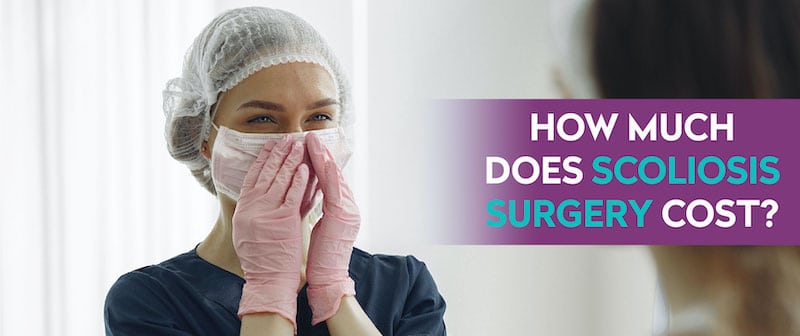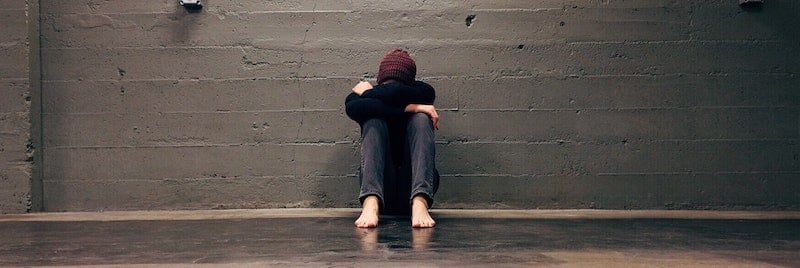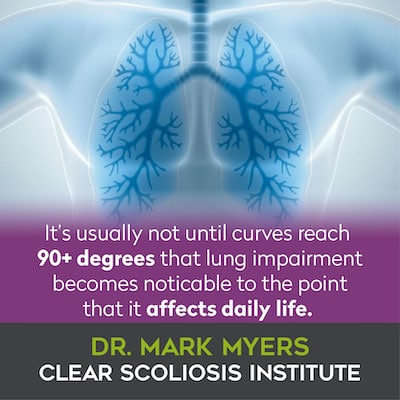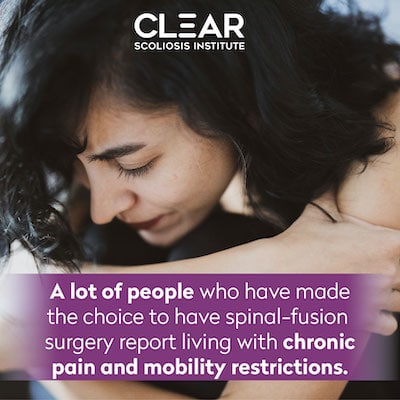
There are many variables that can affect the cost of scoliosis surgery, such as location, surgeon, condition severity, whether or not there are complications, and length of stay in the hospital. Not only is the surgery costly, it’s invasive in nature, and many patients experience subsequent complications or are disappointed with the results.
Part of understanding scoliosis surgery and its potential cost and outcome is understanding the journey that leads people there. Before we break down the monetary costs of surgery, let’s look into the main reasons people come into the CLEAR Scoliosis Institute in the first place.
Usually, there are three main reasons patients come to see us at CLEAR: pain, wanting to be proactive, and seeking a second opinion after being told they need surgery.

The first reason, pain, is the least common. This is because the age group most commonly diagnosed with scoliosis is adolescents between the ages of 10 and 18. For this age group, due to growth and lack of compression, their scoliosis rarely causes pain.
The second reason is people wanting to be proactive. These people might be aware that surgery is an option, but they want to research treatments that can reduce their curvature in a less invasive, more functional way.
The third reason is people facing surgery after being told it’s necessary and wanting to learn more about options that could help them avoid it. Often, these patients are frightened of impending surgery, and it’s that fear that brings them in to find out if there are any treatment options they’re unaware of.
Regardless of the reason a patient comes in to see me, my goal is to educate them on their options, and here at CLEAR, we feel that surgery isn’t always the best option.
When it comes to determining the average cost of scoliosis surgery, keep in mind that there are numerous unpredictable variables that will impact the final cost. No one knows just how a surgery will go until that patient is opened up and on the table.
Although surgeons have their patients’ best interests at heart, every surgery comes with the risk of complications. Whether or not there are complications during surgery impacts its final cost and outcome.
Common variables that impact the average cost of scoliosis surgery include the surgeon, location of the surgery, whether or not there are complications that lengthen the surgery, the length of hospital stay, and the level of recovery care needed post-surgery.
On average, the cost of surgery ranges from $140,000 to $175,000. The cost of scoliosis surgery is generally broken down like this: [1]
This average cost would be for full spinal surgery: thoracic to lumbar.
Scoliosis surgery is more commonly performed on children than adults. According to the National Scoliosis Foundation, 38,000 patients receive spinal fusion surgery each year. [2]

Surgery is typically recommended when a curvature reaches a certain Cobb angle. This varies somewhat from country to country. In the United States, it’s often recommended for patients whose Cobb angle is 40+ degrees, and in Europe that benchmark is generally 50+ degrees.
Spinal-fusion surgery for people with scoliosis involves installing hardware to hold the spinal vertebrae together while they fuse into a straighter alignment. The surgery is lengthy and complex.
Every year, approximately 8,000 people who undergo scoliosis surgery in their youth are defined as permanently disabled. [3]
Follow-up X-rays performed on patients who had surgery 22 years earlier often show that their spines have returned to pre-operative levels, meaning the curvature in their spine has returned.
Many people approach spinal-fusion surgery with the hope and belief that their spine will be fully corrected when, realistically, the best-case scenario is that the surgery achieves a 66-percent curvature reduction. [4] People expecting a perfectly straight and fully-functioning spine post-surgery will be disappointed.
That’s why surgery is often recommended to be done sooner than later, because it increases the potential rate of curvature reduction. The less of a correction that’s needed means better results.
In addition to the loss of strength and flexibility in the spine that many patients experience post-surgery, there are other potential side effects to be aware of:
When a spine is ‘held’ in a straighter alignment with hardware, rather than corrected structurally, that spine is less able to distribute force and impact evenly, leading to post-surgery activity restrictions.
Patients who’ve had scoliosis surgery often struggle with fear of their spine snapping or hardware malfunctioning, and that fear can keep them from trying new things or participating in the activities they were able to do before surgery.
These are all factors I want my patients to be aware of so they can make a fully-informed decision regarding treatment options and how to live their best lives with the condition.
The first thing I would say to a patient who’s considering scoliosis surgery is that no one should consider it without being fully informed. I want every patient to know all their options and have a realistic idea of what life can be like post-surgery. I like to make sure their expectations are aligned with potential outcomes.
I would also want to make sure that no one is considering surgery out of fear or because they feel there are no other options.

The research is clear that people with abnormal spinal curvatures can remain fully functional. What I want to impart to people is an awareness that there are less-invasive conservative treatment options with proven positive results. [5]

There are many factors that go into determining the final cost of scoliosis surgery, but on average, you can expect to pay anywhere from $140,000 to $175,000. While cost is an important factor to consider, I caution people to ensure they’re aware of the non-monetary costs of scoliosis surgery as well.
In addition to researching all of the treatment options available, I want people to really make sure that their expectations of what spinal-fusion surgery can do for them are aligned with potential outcomes.
There are also a lot of potential side effects that go along with scoliosis surgery, and people need to know about all of them to make a fully-informed decision. People need to be aware of the limitations that they can experience post-surgery. A decrease in the spine’s ability to absorb force and maintain flexibility are outcomes that a lot of people don’t expect and are disappointed with.
Here at CLEAR, we are dedicated to educating people on alternative treatment options that are less invasive, cost-effective, don’t carry side effects, and don’t cost the spine its strength and flexibility.
[2] National Scoliosis Foundation
Clear-institute.org - The CLEAR Approach
The author’s views are his or her own and may not reflect the views of CLEAR Scoliosis Institute.

CLEAR provides a unique and innovative way of understanding scoliosis. Sign up to receive facts and information you won’t find anywhere else.

I am interested in a less invasive option for my scoliosis. I was diagnosed at the age of 15 with a double curvature. i had already finished growing and there was no treatment given. i am 64 and would like to either partially correct and definitely slow/stop it's progression. I exercise and stay active and am healthy.
Hello, Kari,
Thank you for reaching out. Our CLEAR Scoliosis Institute Doctors are trained and certified in treating scoliosis to avoid surgery or other invasive procedures. It appears you were diagnosed as Adolescent Idiopathic Scoliosis even though you are currently an adult. This does not hinder the possibility of success with treatment, in most cases. To determine if this care is right for you or if you would be a candidate for care, I recommend contacting the nearest CLEAR Scoliosis Center to you. To find this information, please visit our website under "Find a Doctor". Best of luck.
Hi, I am a 25-year-old man and I recently found out I have a double curvature after x rays were performed on my chest in march. Before the x-ray scan, I was screened with a cobbs angle at 45 degrees putting me in the severe category for my scoliosis, this was back in 2017 I believe. I really want the surgery done so that I might finally be rid of my back pain and potentially reduce the progression of my spine curvature. This is important to me since I'm training to be a merchant mariner (sailor) and I want my quality of life to improve once I graduate but before I enter the workforce.
Please help me identify my options as I feel my life is looking bleaker every day that goes by and i'm afraid I may become depressed without knowing if my life is going to every improve.
Hello, Ethan,
The CLEAR Scoliosis Institute Doctors work with patients to avoid surgery as much as possible, or to increase their flexibility and balance muscle tone prior to surgery; however, we do not perform surgery. If you have a surgery already scheduled, going through treatment at one of our centers can help in making your surgery more successful. If you do not have a surgery planned and would like to avoid surgery, that is also a possibility. A 45 degree curvature can oftentimes be reduced and stabilized and therefore avoid scoliosis surgery altogether. I would suggest contacting the CLEAR Scoliosis Center nearest to you to determine if you would be a candidate for treatment. The nearest center can be found on our website under Find a Doctor. Best of luck.
This post was really informative! I had no idea how much scoliosis surgery could cost or the factors that influence the price. It’s helpful to see the breakdown of potential expenses. Thanks for sharing this valuable information!
This post really helped clarify the costs associated with scoliosis surgery. I had no idea how much variation there could be based on factors like location and hospital choice. Thank you for breaking it down so clearly!
Thank you for breaking down the costs of scoliosis surgery! It’s so helpful to understand not only the surgery expenses but also the additional costs that might come up, like follow-ups and physical therapy. This information is really important for anyone considering their options.
We just found out our 16 year old son has a 60 degree curvature and the doctor said the surgery is really the only option so it does not become worse. Is that true? I am worried about the cost but also about my son's long term health. He does have quite a bit of discomfort and pain. Thank you
Hello, Bryan,
Ultimately, care for your son is your choice. A 60 degree curvature is severe; however, our CLEAR Scoliosis Institute certified Doctors have treated curvatures of this magnitude with great success in helping them to avoid surgery. Each case is obviously different, however, surgery is always an option as a last resort. If you are interested in finding out if your son would be a candidate for treatment at one of our CLEAR Scoliosis Centers, I suggest contacting the CLEAR Scoliosis Center closest to you. To find the nearest clinic, please visit our website under Find a Doctor. The sooner you seek treatment for a condition, the better the treatment outcome, whereas when a condition worsens, it becomes more difficult to treat, and scoliosis is a progressive condition that worsens over time. Please let us know if we can be of further assistance. Best of luck.